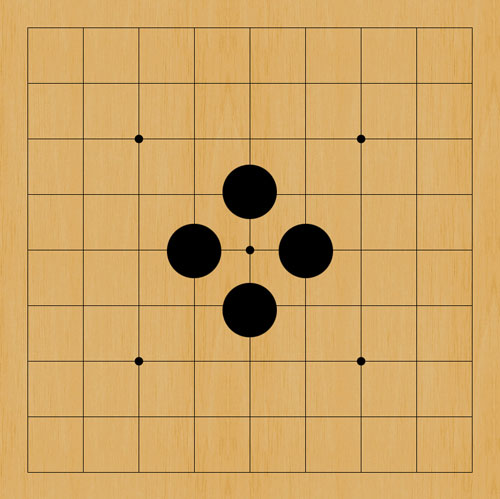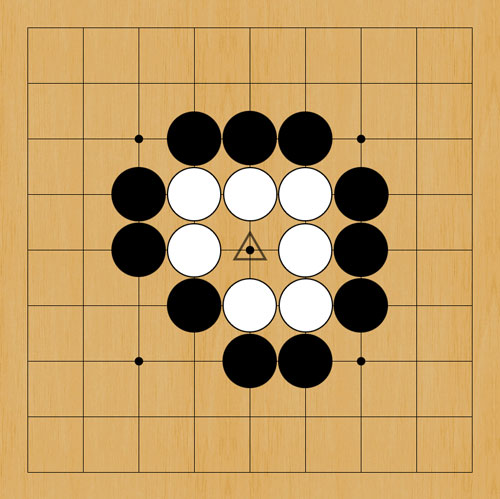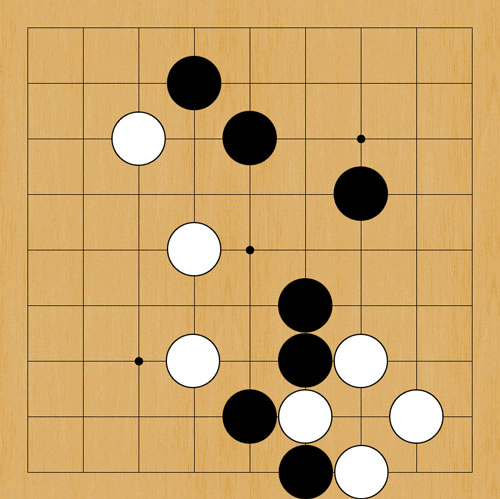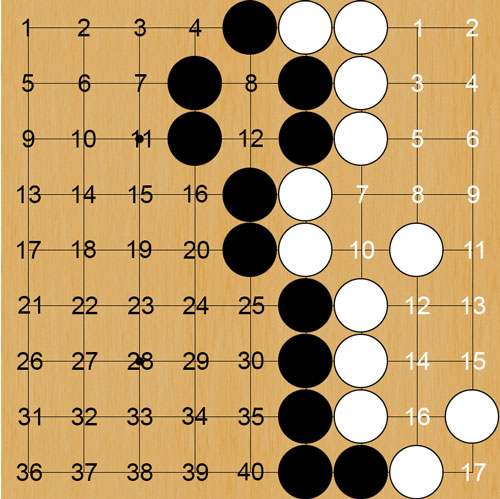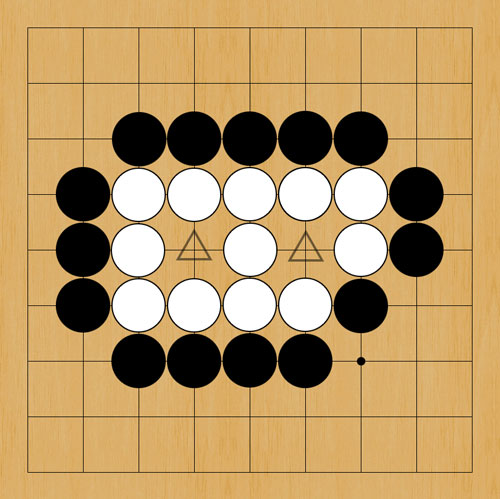How To Play Go
Below we teach the rules of Go and provide a few tips at the end. For video walkthroughs on how to play the game you can refer to the YouTube video lessons by Stephanie Yin, 1 Dan Professional, from the New York Institute of Go.
Contents:
The Fundamentals
Go is played on a board consisting of 19 horizontal and vertical lines (19×19). There are also smaller boards consisting of 13×13 and 9×9 lines.
The game is played by two players, each of whom take turns placing a single stone on an intersection of the vertical and horizontal lines. The player taking the black stone plays first, followed by the player taking white.
Once a stone is placed on the board it cannot be moved. But, it can be removed from the board if it is captured (more on this later).
The Goal
The objective of Go is, at the end of the game, to end up with more points than your opponent. This is achieved by three means: surrounding points (intersections) on the board with your stones, capturing your opponent’s stones, and due to black receiving the advantage of playing first, white receives 6.5 points in compensation, this is known as the “komi”.
Capturing Stones
Each intersection that is directly connected to a stone is known as its “liberty”, marked “X” in Diagram #1.
When all of the stone’s liberties are filled by the opponent’s stones, the stone is then “captured”, or “killed”, and removed from the board. This stone then becomes the opponent’s prisoner and is counted as one of their points.
Diagram #2. Black has filled three out of four of the middle white stone’s liberties. With one more move black can capture the white stone. When there is only one liberty left the stone is said to be in “atari”.
Diagram #3 shows black filling the final liberty. The white stone is now captured and removed from the board, adding to black’s points.
Diagram #4. To avert the capturing of white’s stone, white can place another stone on one of its current liberties.
A group of stones are stones that are connected to each other either horizontally or vertically. Diagonals do not count. A group shares all of the liberties of its stones. When these spaces are all filled by the opponent, the group is captured.
Groups come in all shapes and sizes and can have many liberties. Below are examples of small groups and their liberties.
If black wanted to capture one of the above groups, say Diagram #6, they would need to fill all of the surrounding liberties of white. They can then remove all of the white stones from the board.
There is one final rule in relation to capturing groups, but first, a word on illegal moves.
An illegal move is one that causes the immediate capture and removal from the board, of a players own stone or group. An example of this is explained and shown below in Diagram #9.
If a group has one surrounded, internal liberty, it is an illegal move for the opponent to play in said liberty as it would itself be captured automatically due to not having any liberties of its own. The opponent must first fill all of the outside liberties of that group, and only then can they play on the internal liberty to capture the entire group.
Diagram #9 shows white with eleven outside liberties, each marked with “X”, and one internal liberty, marked with a triangle. Black cannot start the attack by playing at the triangle as it would be an automatic capture for the black stone by white, i.e. an illegal move. Black must first fill all of the outside liberties.
Diagram #10 shows black having filled all of the outside liberties. White is now in atari.
Finally, Diagram #11 shows black having filled in white’s internal liberty to capture the entire group.
Ko
“Ko” in Japanese means “eternity”.
The ko rule in go prevents an infinite loop of recapturing the same stones.
Sometimes, when a stone is captured, there may exist an option to recapture immediately, which would cause the position to repeat. See Diagram #12 below.
The ko rule says that immediately recapturing, and thus repeating the board position, is not allowed. However, you can play elsewhere, and if the opponent also plays elsewhere, then you can return to the ko position and recapture the stone, see Diagram #13 below.
Diagram #13 above. White cannot recapture black immediately on move 2, and instead must play elsewhere. Black can also play elsewhere, allowing white to recapture on move 4. This does not repeat the board position so it is allowed.
The ko ends when either player fills in the centre liberty with one of their own stones or by capturing any of the opponent’s other stones that are involved in the ko shape. Move 6 by white captures a black stone and ends the ko.
Territory and Counting
To win a game of Go you must, at the end of the game, have more points than your opponent.
There are three ways to make points in Go: territory, prisoners and komi.
- Territory: The intersections surrounded by your stones. One intersection equals one point.
- Prisoners: Opponent’s stones captured over the course of the game and opponent’s stones deemed dead at the end of the game.
- Komi: 6.5 points added to white’s score at the end as compensation for going second at the start of the game.
Diagram #14 shows the end of a game. A game concludes when both players agree that there is nothing left to be played on the board and both say “pass”. Alternatively, you can resign at any point of the game which results in your opponent’s victory.
In this diagram black has surrounded the left side of the board and white surrounds the right side. Notice that you do not need to play on the edges of the board, they are considered surrounded.
You can see in Diagram #15 that each intersection, numbered in black for black’s territory and white for white’s, counts as one point. Black has 40 points of territory and white has 17. White gets 6.5 points of komi, added together that is 23.5 points for white in total. No prisoners for either side. A clear win for black.
Tip: There is no rule in go that you cannot play inside your opponent’s territory. (Read the Tips section below for more on this)
And that’s it! You now know how to play go!
If you have any questions you are very welcome to join us on the IGA Discord channel where our members can answer your questions and talk about Go in general. The online club meets on Thursdays at 8pm on Discord along with the OGS Ireland room where we play games against one another.
We also have clubs in Dublin, Lisburn, Belfast, Galway and Cork where each week you can play and learn in-person. All are welcome.
We hope to play with you!
Tips
1. Alive Groups
While not a set of rules, the concept of groups that are alive or dead is important to know to be able to effectively play the game.
We have already established how to capture stones and a group with an internal liberty in diagrams 9-11. The internal liberty of those groups is referred to as an “eye”. Two eyes are required for a group to be impossible to kill. Here are a few examples of white groups with two eyes, with the eyes marked with a triangle:
These examples show different ways of making two eyes depending on their location on the board.
Remember illegal moves? If you notice, no matter which internal liberty (eye) black decides to put a stone in, it is illegal to do so because he would be captured automatically. And since black can’t play two moves at the same time it means that there is no way to capture any group with two eyes, even if all of the outside liberties are filled.
Diagram #18 is used to show that the group can be of any shape, as long as it is one connected group the eyes can be anywhere on the board and the group is safe.
2. There is no rule in go that you cannot play inside your opponent’s territory
Here’s a really interesting part of the game.
If you can make a living group, i.e. a group with a minimum of two eyes, then the area that you possess is no longer counted as the opponent’s points but yours, and therefore they must surround you to keep as many points as they can.
Going back to Diagram #14, there is a lot of space in the bottom left area of the board – perhaps enough for white to make two eyes?
In Diagram #19 white plays in the bottom left and manages to make two eyes in the corner. Black, unable to kill white’s stones has suffered a huge points loss. In the course of the play, one white stone is left for dead in the top left.
Diagram #20 shows what are now counted as points. The lone white stone in the top left has no way to live as black would thwart any attempt by white to do so. White does not try to make it into a living group and so, abandoned, the white stone is automatically counted as one of black’s prisoners at the end of the game. Once the game has ended black removes the white stone from the board without ever having to actually surround, capture and remove it during the game.
Result:
| Black | White | |
| Territory | 24 | 19 |
| Prisoners | 1 | 0 |
| Komi | 0 | 6.5 |
| Total | 25 | 25.5 |
White wins by 0.5 points.
The green circle in the bottom left of Diagram #21 is a neutral point. It is a point on the border of both coloured stones that is of no value to either player, so it is left unplayed and both players can pass. It counts as no points for either side as no single colour is surrounding it to claim it as their own.






